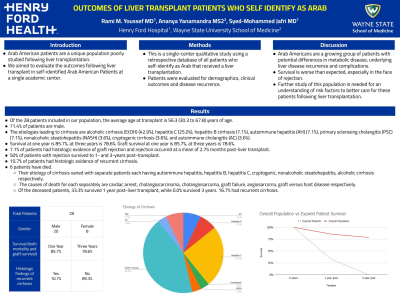Monday Poster Session
Category: Liver
P2911 - Outcomes of Liver Transplantation in Arab American Patients: A Single Center Experience
Monday, October 28, 2024
10:30 AM - 4:00 PM ET
Location: Exhibit Hall E

Has Audio
- AY
Ananya Yanamandra
Wayne State University School of Medicine
Detroit, MI
Presenting Author(s)
Rami M. Youssef, MD1, Ananya Yanamandra, 2, Syed-Mohammed Jafri, MD3
1Henry Ford Hospital, Detroit, MI; 2Wayne State University School of Medicine, Detroit, MI; 3Henry Ford Health, Detroit, MI
Introduction: Arab American patients are a unique population poorly studied following liver transplantation. We aimed to evaluate the outcomes following liver transplant in self-identified Arab American Patients at a single academic center.
Methods: This is a single-center qualitative study using a retrospective database of all patients who self-identify as Arab that received a liver transplantation. Patients were evaluated for demographics, clinical outcomes and disease recurrence.
Results: Of the 28 patients included in our population, the average age at transplant is 56.3 (30.3 to 67.8) years of age and 71.4% of patients are male. The etiologies leading to cirrhosis are alcoholic cirrhosis (42.9%), hepatitis C (25.0%), hepatitis B cirrhosis (7.1%), autoimmune hepatitis (7.1%), primary sclerosing cholangitis (7.1%), nonalcoholic steatohepatitis (3.6%), cryptogenic cirrhosis (3.6%), and autoimmune cholangitis (3.6%). Survival at one year is 85.7%, at three years is 78.6%. Graft survival at one year is 85.7%, at three years is 78.6%. 7.1% of patients had histologic evidence of graft rejection and rejection occurred at a mean of 2.75 months post-liver transplant. 50% of patients with rejection survived to 1- and 3-years post-transplant. 10.7% of patients had histologic evidence of recurrent cirrhosis. 6 patients have died. Their etiology of cirrhosis varied with separate patients each having autoimmune hepatitis, hepatitis B, hepatitis C, cryptogenic, nonalcoholic steatohepatitis, alcoholic cirrhosis respectively. The causes of death for each separately are cardiac arrest, cholangiocarcinoma, cholangiosarcoma, graft failure, angiosarcoma, graft versus host disease respectively. Of the deceased patients, 33.3% survived 1 year post-liver transplant, while 0.0% survived 3 years. 16.7% had recurrent cirrhosis.
Discussion: Arab Americans are a growing group of patients with potential differences in metabolic disease, underlying liver disease recurrence and complications. Survival is worse than expected, especially in the face of rejection. Further study of this population is needed for an understanding of risk factors to better care for these patients following liver transplantation.
Disclosures:
Rami M. Youssef, MD1, Ananya Yanamandra, 2, Syed-Mohammed Jafri, MD3. P2911 - Outcomes of Liver Transplantation in Arab American Patients: A Single Center Experience, ACG 2024 Annual Scientific Meeting Abstracts. Philadelphia, PA: American College of Gastroenterology.
1Henry Ford Hospital, Detroit, MI; 2Wayne State University School of Medicine, Detroit, MI; 3Henry Ford Health, Detroit, MI
Introduction: Arab American patients are a unique population poorly studied following liver transplantation. We aimed to evaluate the outcomes following liver transplant in self-identified Arab American Patients at a single academic center.
Methods: This is a single-center qualitative study using a retrospective database of all patients who self-identify as Arab that received a liver transplantation. Patients were evaluated for demographics, clinical outcomes and disease recurrence.
Results: Of the 28 patients included in our population, the average age at transplant is 56.3 (30.3 to 67.8) years of age and 71.4% of patients are male. The etiologies leading to cirrhosis are alcoholic cirrhosis (42.9%), hepatitis C (25.0%), hepatitis B cirrhosis (7.1%), autoimmune hepatitis (7.1%), primary sclerosing cholangitis (7.1%), nonalcoholic steatohepatitis (3.6%), cryptogenic cirrhosis (3.6%), and autoimmune cholangitis (3.6%). Survival at one year is 85.7%, at three years is 78.6%. Graft survival at one year is 85.7%, at three years is 78.6%. 7.1% of patients had histologic evidence of graft rejection and rejection occurred at a mean of 2.75 months post-liver transplant. 50% of patients with rejection survived to 1- and 3-years post-transplant. 10.7% of patients had histologic evidence of recurrent cirrhosis. 6 patients have died. Their etiology of cirrhosis varied with separate patients each having autoimmune hepatitis, hepatitis B, hepatitis C, cryptogenic, nonalcoholic steatohepatitis, alcoholic cirrhosis respectively. The causes of death for each separately are cardiac arrest, cholangiocarcinoma, cholangiosarcoma, graft failure, angiosarcoma, graft versus host disease respectively. Of the deceased patients, 33.3% survived 1 year post-liver transplant, while 0.0% survived 3 years. 16.7% had recurrent cirrhosis.
Discussion: Arab Americans are a growing group of patients with potential differences in metabolic disease, underlying liver disease recurrence and complications. Survival is worse than expected, especially in the face of rejection. Further study of this population is needed for an understanding of risk factors to better care for these patients following liver transplantation.
Disclosures:
Rami Youssef indicated no relevant financial relationships.
Ananya Yanamandra indicated no relevant financial relationships.
Syed-Mohammed Jafri: Gilead, Takeda, Abbvie, Intercept, VectivBio – Advisor or Review Panel Member, Speakers Bureau.
Rami M. Youssef, MD1, Ananya Yanamandra, 2, Syed-Mohammed Jafri, MD3. P2911 - Outcomes of Liver Transplantation in Arab American Patients: A Single Center Experience, ACG 2024 Annual Scientific Meeting Abstracts. Philadelphia, PA: American College of Gastroenterology.

